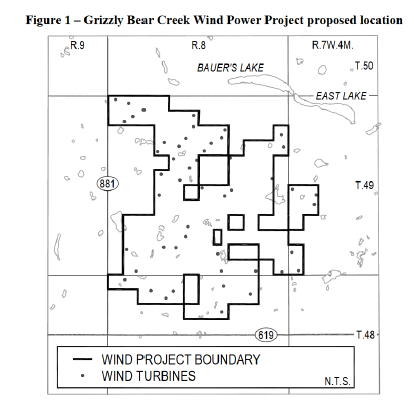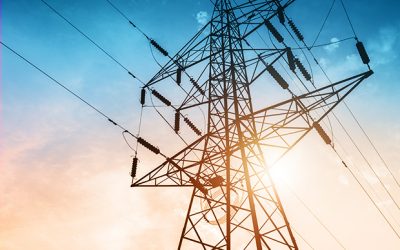Facilities – Wind Farm
E.ON Climate & Renewables Ltd. (“EON”) applied to the AUC for the construction and operation of the Grizzly Bear Creek Wind Power Project (the “Project”). The Project consists of:
-
Fifty 2.4-megawatt (MW) wind turbines, with a total capacity of 120 MW;
-
Each tower would be 91 metres tall and have a rotor diameter of 116.8 metes;
-
A 34.5-kilovolt (kV) collector system of underground power lines in the Project area; and
-
The Grizzly Bear Cree Wind Power Project Substation 708S for future connection to the Alberta Interconnected Electrical System (“AIES”).
The Project would be located within Township 48, Range 8, west of the Fourth Meridian and Township 49, Ranges 7 and 8, west of the Fourth Meridian, as shown in the following map:
A group of landowners, known as the Grizzly Bear Coulee Projection Group (“GBCPG”) objected to the Project.
Consultation
EON submitted that it conducted a participant involvement program (“PIP”), in accordance with Rule 007: Applications for Power Plants, Substations, Transmission Lines, Industrial System Designations and Hydro Developments (“Rule 7”) to build a relationship with stakeholders potentially affected by the Project. EON submitted that it initially identified stakeholders within 800 metres of the boundary of the Project for personal consultation, and stakeholders within 2,000 metres of the Project for public consultation. EON submitted that it conducted its PIP beginning in April 2012, and included phone calls, distribution of information packages, open houses, and Project update information packages as the Project progressed.
EON submitted that it held three open houses for the Project in April 2013, May 2013, and July 2013. EON also noted that it attended a public information session hosted by the GBCPG in November 2013, and prepared information regarding the health effects of living near wind turbines.
EON submitted that it heard concerns about the siting of its turbines, electric and magnetic fields, shadow flicker, noise, weed control, effects on wildlife, visual impacts, local employment and Project reclamation.
The GBCPG submitted that it had concerns with EON’s consultation efforts, specifically related to incomplete project information packages, or misleading information contained in information distributed to stakeholders. The GBCPG submitted that EON should have provided information that was fair, complete and unbiased, which would have resulted in a more fruitful consultation process.
EON disagreed with the assertions that its information was incomplete or biased. EON submitted that the information it provided included peer-reviewed studies, and government-based information. EON contended that the interveners seemed to expect that EON itself should have re-affirmed the interveners’ pre-conceived notions of adverse health effects from wind farms. EON submitted that it was not prepared to do so, given the lack of evidence demonstrating any such adverse health effects.
The AUC found that EON had demonstrated that it made reasonable ongoing efforts to address concerns from stakeholders as they arose, and made efforts to include stakeholders that were missed in the initial stages of consultation.
The AUC acknowledged that an effective consultation program may not resolve all concerns, and that individuals may feel that the consultation efforts were not responsive to their specific interests. The AUC held that the divergent views of the consultation process was not an indication of the quality or the effectiveness of EON’s PIP, but was simply reflective of the fact that the parties did not agree.
The AUC accordingly held that EON’s PIP met the requirements of Rule 7.
Noise
EON submitted a noise impact assessment in support of the application, pursuant to Rule 012: Noise Control (“Rule 12”), which sets permissible sound levels of 50 dBA Leq daytime, and 40 dBA Leq nighttime. EON retained experts to provide evidence regarding noise impacts and turbine noise.
EON submitted that its noise impacts assessment was compliant with Rule 12, and further incorporated a number of conservative assumptions, including assuming that each wind turbine would result in downwind propagation of noise to each receptor, and lower ground absorption rates. EON also noted that its turbine models had five sound operating modes to reduce total noise, but based its modelling assumptions on the sound operating modes not being in use.
EON noted that there were 271 third-party facilities in its study area including six large facilities, two satellite well sites, and 263 individual wells. EON opted for a conservative approach using the maximum observed sound level for the third-party wells and applied it uniformly to all 263, and used actual field measurements for the remaining noise sources.
EON submitted that the Project would meet the permissible sound levels, and would verify compliance with Rule 12 through post-construction sound level monitoring. EON recommended that the five receptor locations with the highest nighttime sound levels between 39.9 dBA Leq and 39.8 dBA Leq be used for the post-construction sound level monitoring, since each was within a margin of compliance of 0.5 dBA.
EON further submitted that it could mitigate any further noise impacts through the operating parameters of each wind turbine to fulfill curtailment plans.
The GBCPG questioned the adequacy of EON’s noise impact assessments, raising concerns about low frequency noise, infrasound, and vibrations from wind turbines on area residents.
Experts retained by GBCPG agreed with many points on EON’s noise impact assessment. However, the experts for GBCPG were of the opinion that the assessment was out-of-date and underestimated third-party noise contribution, and suggested additional fieldwork to ensure that noise emissions from third-parties were adequately quantified. Experts retained by GBCPG also took issue with the noise impact assessment, pointing out that the reports did not explain actual noise impacts on residents, such as impacts on daily activities, or nighttime sleep. Accordingly, GBCPG requested the following requirements for post-construction monitoring, should the AUC approve the Project:
-
Post-construction monitoring be done by a third party with results made available to the AUC and local residents, including members of the GBCPG.
-
Such monitoring must involve full spectrum monitoring, both inside and outside homes, and must be done with complete transparency of the data to all parties, including residents and local health authorities.
-
The monitoring should be made available to any local residents, including members of the GBCPG who request it.
-
E.ON substitute dB Lin, or dB linear, for dBC in the post-construction comprehensive noise study that it has committed to do and that the post-construction comprehensive noise study include infrasound and low frequency noise measurements inside some of the local residents’ homes.
-
The monitoring system should be done in real time and with built-in shutdown mechanisms for when either accepted noise limits are exceeded or when noise nuisance is repeatedly occurring to the residents with a built-in facility for change. As the residents become increasingly sensitized to the pulsing infrasound and low frequency noise, over time, they would therefore need lower and lower limits in order to protect their sleep.
The AUC held that the noise model used by EON met the standards identified in Rule 12, and applied appropriately conservative assumptions. The AUC held that EON’s noise modeling did not require and upward or downward adjustments for the purposes of the noise impact assessment, and rejected the adjustments proposed by the GBCPG.
The AUC determined that the predicted sound levels from the Project were in compl
iance with the daytime permissible sound levels in Rule 12, and nighttime permissible sound levels, provided that specific turbines were operated in sound reducing operating modes. Accordingly, the AUC directed that turbines 22 and 23 in the Project be operated in sound reducing operating modes during nighttime periods.
The AUC included a number of conditions in providing its determination on noise issues. The AUC included conditions relating to the operation of specific turbines in sound optimized modes during nighttime, and required a post-construction noise assessment at six receptor locations, including the locations proposed by EON.
Health
The GBCPG expressed concerns about living in close proximity to wind turbines, including concerns related to audible noise, low frequency noise, and infrasound, as well as shadow flicker and light pollution. Many other GBCPG members also expressed concerns about impacts on lack of sleep caused by the proximity of the wind turbines. The GBCPG pointed to a decision in respect of the Shirley Wind Farm by the Brown County Board of Health, which it submitted declared a wind project as a human health hazard.
The GBCPG submitted that compliance with Rule 12 would not be sufficient to protect nearby residences from health impacts. The GBCPG provided expert testimony that a study conducted on 38 individuals who lived within 1,500 meters of a wind turbines, and examined impacts on sleep quality based on distance from wind turbines. The GBCPG report concluded that sleep quality improves, and sleep impacts decline as distance from a wind turbine increases, with little impacts noted beyond 1,400 meters. Accordingly, the GBCPG submitted that there was a high probability of significant adverse health effects for residents located within 1,400 meters of any of the proposed turbines from the Project.
EON submitted that the Project would not adversely affect the health of nearby residence. EON pointed to studies conducted by Health Canada which concluded that there is no evidence of an association between exposure to wind turbine noise and the prevalence of self-reported or measured heath effects, beyond annoyances, at wind turbine noise levels of up to 46 dBA. EON submitted that the conclusion arrived at by Health Canada supported the conclusion that the Project would not cause adverse health effects, given the results of the noise impact assessment.
The AUC determined that the evidence provided by both parties indicated that audible noise from wind turbines at or above a certain level and distance could be associated with sleep disturbance and annoyance, both of which can lead to adverse health impacts. However, the AUC noted that both parties disagreed on the sound level and distance at which these impacts occur.
The AUC rejected the recommendations of the GBCPG, on the basis that the areas studied were not comparable to the Project, and noted that the increased levels of sleep disturbance and health impacts occurred at levels above 40dBA. Accordingly, the AUC found that the recommendations of the GBCPG did not reflect a reasonable interpretation of the other available scientific evidence.
The AUC held that it preferred the Health Canada study provided by EON, noting that it included a large sample size of residences near wind turbines (and others located up to 11 kilometers away) with over 1200 participants. The AUC noted that the only statistically significant impact determined in the Health Canada study was that blinking lights placed on top of individual turbines would result in an annoyance, and impacted sleep time. The AUC accepted the conclusions arrived at in the Health Canada study, including that self-reported diagnosed sleep disorders and high sleep disturbance was unrelated to wind turbine noise below 46 dBA.
Accordingly, the AUC held that there was no persuasive evidence that the Project would likely result in adverse health effects on nearby residents.
However, with respect to low frequency noise and infrasound, while the AUC determined that health impacts arising from these sources were unlikely, the AUC directed EON to conduct post-construction monitoring for low frequency noise and infrasound levels. The AUC held that, should such post-construction monitoring reveal a low frequency noise condition, EON must mitigate such noise in compliance with Rule 12.
Property Impacts
The GBCPG submitted that the visual impacts and number of turbines in the Project would negatively impact land values. GBCPG members also expressed concerns about the spread of noxious weeds during construction activities, and resulting impacts on agricultural land use. GBCPG members also expressed concerns that they would no longer be able to employ aerial spraying for crops, due to the presence of the wind turbines.
EON submitted that visual impacts are inherently subjective, noting that pre-existing disturbances are present in the Project area, including pump stations, well compressor stations and other oil and gas facilities.
EON submitted that the impacts on property values were not supported by evidence, and noted that most major studies did not find evidence that wind turbines decreased property values. EON also submitted that none of the Project turbines would be located on land owned by GBCPG members.
With respect to agricultural land impacts, EON submitted that it would wash equipment prior to entering on Project lands to prevent the spread of noxious weeds. EON also submitted that aerial spraying concerns were not supported by evidence in the proceeding, however it did commit to working with landowners to accommodate the usage of aerial spraying if the need arises.
The AUC held that visual impacts are subjective in nature, and recognized that the construction and operation of the Project would change the landscape of the project area. However, the AUC noted that the extensive disturbance from oil and gas development in the area was a factor to be taken into consideration.
The AUC held that there was insufficient evidence provided to show that land use would be impacted by the Project, and accordingly the AUC could not conclude that the Project would result in any adverse impacts on property values or agricultural impacts.
Environmental Impacts
EON submitted that the Project area is comprised of cultivated cropland (67 percent), modified pasture (9.1 percent), wetlands (9.2 percent), hay land (6.4 percent) and trees/shrubs (6.0 percent) as well as smaller portions of farmyards (1.9 percent), native pasture (0.2 percent), and dugouts (less than one percent). EON submitted that the Project area did not contain any provincially or federally designated protect areas, Environmentally Significant Areas (“ESA”) or National Wildlife Areas.
EON submitted that it identified 1,718 wetlands in the Project area, mainly as class III and class IV wetlands (which are seasonal and semi-permanent wetlands). EON submitted that the Project had limited potential to alter the hydrology and topography of the area, and that wetland avoidance would be the primary mitigation technique employed during construction and operation.
EON noted that due to heavy agricultural development, much of the native vegetation had been modifie
d or removed, resulting in no listed plant species being recorded during its site surveys, and minimal impacts on wildlife habitat. However, EON committed to post-construction monitoring of the Project for any impacts or effects on bat mortality, noting that its surveys indicated bat mortality risk as potentially moderate during certain conditions. EON also submitted that it had received sign-off from Alberta Environment and Parks (“AEP”).
The GBCPG submitted that the Project would adversely impact wildlife in the area, and submitted that deer, waterfowl, bats, geese, pelicans, blue herons, owls and other migratory birds frequented the Project area. The GBCPG noted that there is an ESA located adjacent to the Project, which may require special considerations due to biodiversity conservation needs. The GBCPG also raised concerns that bat surveys had not been conducted by EON since 2012.
The GBCPG recommended that any approval for the Project should be conditional upon a mitigation framework being established for waterfowl, as well as bats. The GBCPG also recommended that construction occur outside the period of January 15 to April 30 to reduce impacts on wildlife.
The AUC held that the siting of individual turbines on cultivated lands would reduce the potential for adverse environmental impacts, since the lands are pre-disturbed. The AUC held that the sign-off from AEP indicated that the impacts to the environment and on wetlands were acceptable to AEP. The AUC therefore concluded that the siting of the individual turbines was reasonable in the circumstances.
The AUC noted that EON filed bat and bird surveys, however, the AUC noted that the surveys were conducted more than two years prior to the application being filed. Accordingly, the AUC directed EON to conduct pre-construction surveys for wildlife and bat migration, as well as post-construction surveys and monitoring plans for any impacts on wildlife.
Order
The AUC held that, taking into account the negative effects of the Project, which include visual impacts, noise, annoyance and impacts on the environment, any impacts created due to the construction and operation of the Project could be mitigated to an acceptable degree. The AUC determined that, with appropriate mitigation measures, the positive benefits of the project outweigh its negative impacts. Accordingly, the AUC held that the Project would be in the public interest.
The AUC accordingly approved the Project, on the following conditions:
-
EON shall operate turbines 22 and 23 in sound optimized modes during the nighttime period to ensure compliance with the nighttime permissible sound level.
-
EON must ensure that all noise mitigation measures proposed in the application are implemented, to ensure compliance with the permissible sound level at all receptor locations in the study area. The noise control measures proposed in the application included: maintaining the equipment so it is running correctly, implementing wind turbines in sound optimized mode, applying mitigation on third-party energy-related facility noise sources, or the shutting down of wind turbines.
-
EON shall:
(a) Conduct a post-construction comprehensive noise study, including an evaluation of low frequency noise, at six receptors under representative conditions, in accordance with Rule12.
(b) File all studies and reports relating to the post-construction comprehensive noise study with the AUC within one year of connecting the power plant to the Alberta system.
-
If the Project encroaches upon newly identified wetlands, the applicant must re-site the offending Project component(s) or receive AEP’s approval to site the Project within the wetland setback.
-
EON shall conduct a pre-construction spring wildlife survey, which will include birds and amphibians, within two years from the start of construction.
-
EON shall conduct a pre-construction fall bat migration study, within two years from the start of construction.
-
EON shall develop a post-construction monitoring plan in consultation with AEP. Post-construction follow-up surveys will be completed over a minimum of two years to determine changes to bird and bat use of the areas associated with turbines and related infrastructure. A detailed report of the post-construction monitoring will be provided to AEP annually.
-
EON shall develop and implement an environmental protection plan in consultation with AEP.
-
EON shall use the minimum number of lights required by Transport Canada on the turbines, and set these lights to the minimum number of synchronized flashes per minute and the minimum flash duration.




